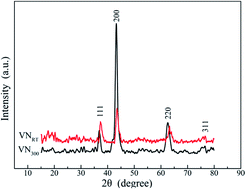Abstract: Consistent stoichiometric FCC structured vanadium nitride (VN) films were fabricated by the pulsed laser deposition (PLD) technique at room temperature and 300 degrees C, for which the microstructures and mechanical and tribological properties were systematically investigated. The results indicated that the films deposited at 300 degrees C displayed a denser structure and possessed higher hardness and elastic modulus values than the films deposited at room temperature that exhibited a columnar structure. The wear behaviors of VN films were investigated at elevated temperature to 900 degrees C against an alumina ball under an ambient atmosphere. Due to the densified structure and excellent mechanical properties, the VN films deposited at 300 degrees C held lower friction coefficients over the investigated temperature range compared to those of the films deposited at room temperature and registered the lowest friction coefficient of about 0.21 at 900 degrees C. According to the XRD and Raman spectroscopy results, the oxidation behaviors of VN films at elevated temperatures formed a series of vanadium oxides, such as V2O5, V3O7, V6O11 and V6O13, which displayed easy crystallographic shear planes with reduced binding strength and influenced the tribological properties significantly. Moreover, liquid self-lubrication existed in the tribology process above 700 degrees C due to the melting of V2O5 that registered low melting points of 680 degrees C. Combining the vanadium oxides phase and lubrication phases with the lubricious oxide layer, as well as the liquid lubrication in the contact area, can cause decreased friction coefficients at higher temperatures. KeyWords Plus: PULSED-LASER DEPOSITION; TIN THIN-FILMS; VANADIUM NITRIDE; TITANIUM NITRIDE; N COATINGS; TEMPERATURE; BEHAVIOR; OXIDATION; FRICTION; PHASE Published in RSC ADVANCES, 6 (40):33403-33408; 10.1039/c6ra02403c 2016
|
